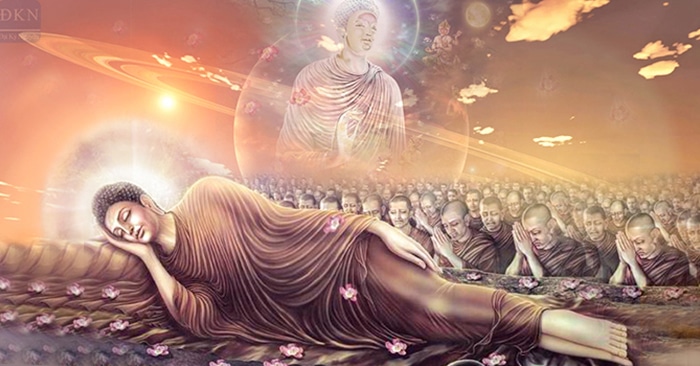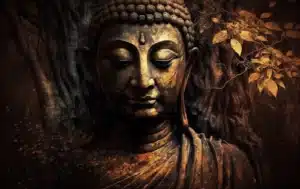Imagine a state of mind so serene and unburdened that it transcends the cycle of suffering, where inner peace reigns supreme, and the trappings of desire and ignorance fade away. This elusive destination, called Nirvana, lies at the heart of Buddhism, beckoning seekers on a transformative journey towards ultimate liberation.
Entering Nirvana means ending the cycle of rebirth, escaping the wheel of life and death. The greed, hatred, and delusion of this realm will cease, transitioning to a state of tranquility, calmness, and clarity, ending all afflictions and suffering.
To be honest with you, LotusBuddhas doesn’t really believe in a place or a state of mind called Nirvana. Just like a delicious dish needs the sourness of lemon, the spiciness of chili, the saltiness of salt, and the sweetness of sugar.
As a human being, emotions like happiness, sadness, or anger are like flavors that make life more interesting, do you think? A state of complete peace, not influenced by external conditions, sounds like the state of a tree! Why would a Buddhist want to become a tree? This question naturally arises when LotusBuddhas explores the concept of Nirvana in Buddhism.
Meaning of Nirvana in Buddhism
Nirvana, in the context of Buddhism, is a Sanskrit term often translated as “extinguishing” or “blowing out”. However, such literal interpretations may not fully capture the multifaceted and profound implications of this concept. Fundamentally, Nirvana denotes the highest state of spiritual attainment, a state of perfect quietude, freedom, and liberation from the cycle of birth, death, and rebirth, known as Samsara.
Nirvana in Buddhism means no birth, no arising, no formation, and not arising from conditions. Those who achieve Nirvana live a serene life, free from afflictions, and no longer bear the consequences of karma. The term also literally means “extinction” or “cessation,” “elimination” of greed, hatred, and delusion in the mind.
Buddhists perceive Samsara as a cycle of suffering and dissatisfaction, engendered by ignorance and perpetuated by desire and attachment. Nirvana, then, signifies the cessation of these root causes—ignorance, desire, and attachment. It is a state beyond all worldly and sensory experience, hence often described in negative terms such as “the absence of suffering”, “the end of illusion”, or “the extinction of desire”. It is the ultimate spiritual goal in Buddhism, the realization of which results in the cessation of further rebirth in Samsara.
Nonetheless, describing Nirvana merely as an end or cessation might unintentionally suggest annihilation or a state of nothingness, which could be misleading. Rather, Nirvana embodies a state of supreme wisdom, mindfulness, and compassion, unfettered by the afflictions of desire, anger, and delusion. It symbolizes a profound peace that comes from a deep understanding of the nature of reality.
Interestingly, Nirvana can be experienced before death, referred to as “Nirvana in this life,” and the person living in this state is known as an Arhat or a fully enlightened being in Theravada Buddhism, and a Bodhisattva in Mahayana Buddhism. Post death, such a being achieves “Parinirvana” or “complete Nirvana”, which marks the complete cessation of the cycle of death and rebirth.
It should also be noted that the concept of Nirvana might slightly vary among different Buddhist traditions. While Theravada tradition focuses on the individual’s pursuit of enlightenment, Mahayana and Vajrayana traditions emphasize the Bodhisattva’s vow to delay their own Nirvana until all sentient beings have achieved enlightenment.
The Characteristics of Nirvana
While it is often challenging to encapsulate the attributes of Nirvana due to its transcendental nature, several distinct characteristics are typically ascribed to it within the Buddhist scriptures.
Cessation of suffering: This is the foremost characteristic of Nirvana. Suffering in Buddhism, arises from attachment, desire and ignorance. The achievement of Nirvana marks the complete cessation of such suffering, thereby bringing about an enduring state of peace and contentment.
Extinguishing of ignorance: Nirvana is characterized by the dispelling of ignorance (avidya), which is fundamentally a lack of understanding or awareness of the true nature of reality. It involves a comprehensive comprehension of the Four Noble Truths and a profound insight into the three marks of existence: impermanence (anicca), unsatisfactoriness or suffering (dukkha), and non-self (anatta).
Freedom from rebirth: In Buddhism, the cycle of birth, death, and rebirth, or Samsara, is viewed as a cycle of suffering. Nirvana signifies liberation from this cycle, hence terminating the process of rebirth. It represents the final goal of Buddhist practice.
Unconditioned state: Nirvana is referred to as the unconditioned (asankhata) state. This term implies that it is beyond the realm of dependent origination (paticca-samuppada), a fundamental Buddhist concept explaining the interconnected, conditional nature of phenomena. Hence, Nirvana is not conditioned by or dependent upon any other phenomenon.
Transcendence: Nirvana is beyond the confines of dualistic thought and ordinary conceptual frameworks. It transcends the typical dichotomies of existence and non-existence, pleasure and pain, or self and other. As such, it is often described in negative terms or via the method of apophasis (speaking about something by stating what it is not), as it surpasses the limitations of language and rational understanding.
Supreme happiness: Nirvana is described in the Dhammapada as the highest happiness (paramam sukham). However, this happiness is not the hedonic pleasure typically associated with sensory gratification. It is a profound, enduring contentment that emerges from liberation from all forms of suffering and desire.
Unborn, unoriginated, uncreated, unformed: These epithets, found in the Udana scripture of the Pali Canon, further underline the unconditioned and transcendent nature of Nirvana. These attributes highlight that Nirvana is beyond the typical processes of birth, creation, and formation, thereby reinforcing its permanence and stability.
Nirvana is Not Heaven, Nor is It Nothingness

Nirvana is neither Heaven nor Nothingness. Consider this analogy: if we conclude that Nirvana is void or non-existent simply because our five senses cannot perceive it, it would be as illogical as a blind person asserting there is no light in the world just because they have never seen it.
The fable of the “Turtle and the Fish” illustrates this well. The fish, knowing only water, adamantly denies the existence of land, based on its limited perception and the turtle’s descriptions, all negating the characteristics of water.
There was once a fish that knew only water and was ignorant of anything beyond it. One day, while swimming in its usual pond, it encountered the turtle. Upon inquiry, it learned the turtle had been wandering on dry land. Surprised, the fish asked about this ‘dry land,’ a concept it found incomprehensible, equating the lack of familiar water characteristics with non-existence.
With gentle patience, the turtle acknowledged the fish’s skepticism but reaffirmed its experience of dry land. Despite the turtle’s descriptions, the fish interpreted the absence of water-like qualities as evidence of void, equating unfamiliarity with nonexistence.
However, the turtle suggested that such assertions of void were due to the fish’s limited understanding. The story implies that, just as the fish couldn’t grasp the concept of land due to its sole familiarity with water, similarly, even the Arhats, who have known temporal and transcendent states, cannot employ worldly language to depict transcendental reality, which is beyond worldly comprehension.
Nirvana is likened to the void in that it coincides with space (akasa), both being eternal and unchanging. Space is eternal because it represents emptiness, yet Nirvana exists beyond space and time. The distinction is crucial: space may signify emptiness, but Nirvana embodies existence.
Therefore, Nirvana is not mere voidness nor simply an end. It’s indefinable in worldly terms because it is absolute, unique, and must be realized personally (paccatam veditabbo).
What is a Nirvana Achiever Called?

An individual who achieves Nirvana in the Buddhist tradition is generally referred to as an “Arhat” or an “Arahant” in the context of Theravada Buddhism, and as a “Bodhisattva” within the Mahayana tradition.
An Arhat, derived from the Sanskrit term “arhat” meaning “worthy one” or “perfected one”, is considered to be a person who has reached the ultimate goal of the Buddhist path. The Arhat, through diligent practice and profound insight, has extinguished the three poisons of greed, hatred, and delusion, thus breaking free from the cycle of Samsara. An Arhat, hence, experiences Nirvana during their lifetime and is released into Parinirvana at death, signifying a state of total liberation and the end of the rebirth process.
On the other hand, in Mahayana Buddhism, the term Bodhisattva is used to denote someone on the path to achieving full Buddhahood for the benefit of all sentient beings. A Bodhisattva, in a spirit of altruism and compassion, seeks to attain Nirvana but delays their own final liberation until all beings are saved from suffering. While a Bodhisattva can experience a form of Nirvana, they vow to remain within the cycle of Samsara to guide others to enlightenment. It’s also worth noting that in Mahayana tradition, the term Arhat is sometimes used, but it carries a slightly different connotation, typically referring to a lesser or preliminary stage of enlightenment compared to full Buddhahood.
The Reason Why Bodhisattvas Postpone Nirvana
In Buddhism, Bodhisattvas are individuals who have attained a high level of spiritual realization and have vowed to attain Buddhahood (the state of complete enlightenment) for the benefit of all sentient beings.
One of the reasons why bodhisattvas postpone nirvana (the state of ultimate liberation and freedom from suffering) is that they choose to remain in Samsara to continue helping others.
By postponing their own liberation, bodhisattvas can continue to work towards the liberation and happiness of all sentient beings, and help guide them towards the path of enlightenment. They do this through various forms of compassionate action, such as teaching, serving, and providing guidance and support to those who are suffering.
In essence, bodhisattvas postpone nirvana because they are motivated by a deep sense of compassion and a desire to help others, and are willing to sacrifice their own liberation for the benefit of all beings. This is considered to be a noble and selfless act, and is highly valued in Buddhist teachings.
How to Reach Nirvana in This Life

The attainment of Nirvana, or ultimate liberation, is the primary spiritual goal within the Buddhist tradition. It requires a profound commitment to and understanding of the fundamental teachings of Buddhism, coupled with diligent practice and meditative insight.
Understanding and acceptance of the Four Noble Truths: The Four Noble Truths constitute the foundation of Buddhist teachings. They pertain to the reality of suffering (dukkha), the cause of suffering (samudaya), the cessation of suffering (nirodha), and the path leading to the cessation of suffering (magga). Understanding and internalizing these truths is the first step towards attaining Nirvana.
Following the Noble Eightfold Path: The fourth of the Four Noble Truths, the Noble Eightfold Path, provides a practical guideline for ethical conduct, mental discipline, and wisdom. The path comprises right understanding, right intention, right speech, right action, right livelihood, right effort, right mindfulness, and right concentration. It is often categorized into three divisions: moral conduct (sila), concentration (samadhi), and wisdom (panna).
Practice of meditation: Meditation, particularly mindfulness meditation (Vipassana), is a key practice in Buddhism. It helps develop mindfulness, concentration, and insight into the nature of reality, promoting a direct experiential understanding of the Four Noble Truths.
Cultivation of morality and ethical conduct: Living a life of moral integrity is critical on the path to Nirvana. This involves adhering to the Five Precepts of Buddhism: abstaining from taking life, stealing, sexual misconduct, lying, and intoxication.
Development of wisdom and insight: Wisdom (panna) in Buddhism involves a direct, experiential understanding of the impermanent, unsatisfactory, and non-self nature of reality. This wisdom is cultivated through the practice of meditation and mindfulness, and through the study of the Dhamma (the teachings of the Buddha).
Cultivation of the paramitas: In Mahayana Buddhism, the cultivation of the six paramitas (generosity, moral discipline, patience, effort, meditative concentration, and wisdom) is emphasized. These virtues are viewed as essential qualities that a Bodhisattva must develop on the path to Buddhahood.
Guidance of a spiritualteacher: A knowledgeable and experienced spiritual teacher or guide can be instrumental in navigating the path to Nirvana. They can provide valuable teachings, guidance, and support to facilitate understanding and practice.
You must to note that the attainment of Nirvana is not a straightforward or simplistic process, nor is it viewed as a tangible goal or destination. Instead, it is an experiential state of liberation and peace that arises from the comprehensive realization of the Buddha’s teachings, the cessation of ignorance and desire, and the cultivation of wisdom, ethical conduct and meditative insight.
Two Types of Nirvana

In Buddhist teachings, particularly within the Theravada tradition, Nirvana is typically conceptualized in two forms: Nirvana During Life (or Nirvana with remainder), and Nirvana After Death (or Nirvana without remainder – Parinirvana).
Nirvana During Life (Nirvana with remainder)
This refers to the state in which an individual, typically referred to as an Arhat in the Theravada tradition, has achieved enlightenment or spiritual liberation while still alive. In this state, the Arhat has extinguished the defilements of ignorance, desire, and aversion, and thus, is liberated from the cycle of suffering and rebirth, signifying the attainment of Nirvana.
Despite this spiritual liberation, however, the physical and mental remnants from past karma still persist. This means that the Arhat continues to experience sensations and thoughts and live out their natural lifespan, albeit untouched by the mental afflictions and sufferings that bind unenlightened beings to the cycle of Samsara. Hence, this state is termed ‘with remainder,’ indicating the existence of the karmic residue of the body-mind complex.
Nirvana After Death (Nirvana without remainder – Parinirvana)
This state is achieved upon the death of the Arhat. With the death of the physical body, all karmic residues cease, leading to a state often described as ‘blowing out’ or ‘extinguishing.’ It signifies the complete cessation of the cycle of birth, death, and rebirth. It is termed ‘without remainder’ because no trace of the individual, neither physical nor mental, remains to be subject to the cycle of Samsara. This state is also referred to as Parinirvana, a term often used interchangeably with Nirvana After Death.
These two types of Nirvana elucidate the nature of enlightenment and liberation as understood in Buddhism. However, they should not be misconstrued as two distinct or separate states. Instead, they represent different aspects of the same ultimate liberation, distinguished primarily by whether or not the enlightened individual is still alive. Moreover, as with many aspects of Buddhist philosophy, interpretations may vary among different Buddhist traditions and schools.
Nonetheless, the primary objective of all forms of nirvana remains constant: the pursuit of total liberation and emancipation from suffering. That’s right! Happiness is the goal that we all are pursuing, isn’t it? And Nirvana is the place where true happiness always exists.






